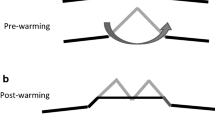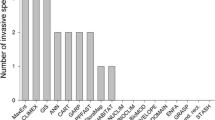Abstract
Managing the threats posed by invasive alien species currently may involve a mixture of species-specific and pathway-specific policy and operational measures aimed at achieving a socially acceptable level of protection. In order to decide how to allocate scarce biosecurity resources in a manner that avoids erecting technical barriers to trade, it is necessary to undertake risk assessments for individual pests or commodity pathways. Whilst there are popular climatic niche tools available to project future pest risk in terms of a species’ potential distribution, the international legal frameworks as yet have no explicit means of including future risk considerations arising from projected climate changes. Nor are there any tested and accepted tools for projecting shifts in geographic pest risk, or systematically identifying future pest risks. I use New Zealand as a case study to demonstrate a method for identifying generic geographic pest risk to a jurisdiction under historical and future climate scenarios. Under future climates, the global area from which threatening pests could originate is set to increase. Pests from some regions that presently require warmer conditions than can be found in New Zealand are likely to become a future threat. These pests will probably originate from regions presently experiencing a sub-tropical climate. As climates warm, regions that have previously been too cool to pose a pest threat will start posing a threat, particularly from rapidly dispersing ruderal species and other generalists. Taking all of the different types of threats into account, the largest increase in risk area for New Zealand appears to be in northern Europe, North America and Asia. This technique can be used to alert biosecurity pathway managers about the shifting direction from which climatically suitable biological invaders may originate, and can also be used to generate pests lists for species that are presently unsuited to the jurisdiction, but may in the future become so if global temperatures rise as expected. The results highlight the need for adaptive biosecurity systems that can recognise and assesses future risk trends, monitor these trends, and are able to respond rapidly to changing threats.






Similar content being viewed by others
References
Andrewartha HG, Birch LC (1954) The distribution and abundance of animals. University of Chicago Press, Chicago
Andrewartha HG, Birch LC (1984) The ecological web: more on the distribution and abundance of animals. University of Chicago Press, Chicago
Baker RHA, Sansford CE, Jarvis CH, Cannon RJC, MacLeod A, Walters KFA (2000) The role of climatic mapping in predicting the potential geographical distribution of non-indigenous pests under current and future climates. Agric Ecosyst Environ 82:57–71
Biosecurity Council (2003) Tiakina Aotearoa Protect New Zealand: the biosecurity strategy for New Zealand. The Biosecurity Council, Wellington, p 63
Blackburn TM, Cassey P, Lockwood JL (2009) The role of species traits in the establishment success of exotic birds. Glob Change Biol 15:2852–2860
Cannas SA, Marco DE, Paez SA (2003) Modelling biological invasions: species traits, species interactions, and habitat heterogeneity. Math Biosci 183:93–110
IPCC, TGCIA, Carter TR, Hulme M, Lal M (1999) Guidelines on the use of scenario data for climate impact and adaptation assessment. Intergovernmental Panel on Climate Change, p 69
Committee on the scientific basis for predicting the invasive potential of nonindigenous plants and plant pests in the United States (2002) Predicting invasions of nonindigenous plants and plant pests. National Academy Press, Washington, DC, USA
Franco M, Silvertown J (1996) Lifehistory variation in plants: an exploration of the fast-slow continuum hypothesis. Philos Trans R Soc Lond B 351:1341–1348
Grime JP (1979) Primary strategies in the established phase. In: Grime JP (ed) Plant strategies and vegetation processes. Wiley, Chichester New York, pp 7–55
Guisan A, Zimmermann NE (2000) Predictive habitat distribution models in ecology. Ecol Model 135:147–186
IPCC (2007a) Climate change 2007: mitigation. Contribution of Working Group III to the fourth assessment report of the intergovernmental panel on climate change. Cambridge University Press, Cambridge, United Kingdom and New York, NY, USA
IPCC (2007b) Climate change 2007: The physical science basis. Contribution of Working Group I to the fourth assessment report of the intergovernmental panel on climate change. In: Solomon S, Qin D, Manning M, Chen Z, Marquis M, Averyt KB, Tignor M and Miller HL (eds) Cambridge University Press, Cambridge, United Kingdom and New York, NY, USA
Köppen WP (1936) Das Geographische System der Klimate [The geographical system of the climate]. In: Köppen W, Geiger GC (eds) Handbuch der Klimatologie. Gebrüder Bornträger, Berlin, p 44
Kottek M, Grieser J, Beck C, Rudolf B, Rubel F (2006) World map of the Köppen-Geiger climate classification updated. Meteorol Z 15:259–263
Kriticos DJ, Randall RP (2001) A comparison of systems to analyse potential weed distributions. In: Groves RH, Panetta FD, Virtue JG (eds) Weed risk assessment. CSIRO Publishing, Melbourne, pp 61–79
Kriticos DJ, Phillips CB, Suckling DM (2005) Improving border biosecurity: potential economic benefits to New Zealand. N Z Plant Protect 58:1–6
Leung B, Lodge DM, Finoff D, Shogren JF, Lewis MA, Lamberti G (2002) An ounce of prevention or a pound of cure: bioeconomic risk analysis of invasive species. Proc R Soc Lond B Biol Sci 269:2407–2413
New M, Lister D, Hulme M, Makin I (2002) A high-resolution data set of surface climate over global land areas. Clim Res 21:1–25
Paini DR, Worner SP, Cook DC, De Barro PJ, Thomas MB (2010) Using a self organising map to predict invasive species: sensitivity to data errors and a comparison with expert opinion. J Appl Ecol
Parmesan C, Ryrholm N, Stefanescu C, Hill JK, Thomas CD, Descimon H, Huntley B, Kaila L, Kullberg J, Tammaru T, Tennent WJ, Thomas JA, Warren M (1999) Poleward shifts in geographical ranges of butterfly species associated with regional warming. Nature 399:579–583
Parmesan C, Gaines S, Gonzalez L, Kaufman DM, Kingsolver J, Townsend Peterson A, Sagarin R (2005) Empirical perspectives on species borders: from traditional biogeography to global change. Oikos 108:58–75
Peacock L, Worner S (2006) Using analagous climates and global insect distribution data to identify potential sources of new insect pests in New Zealand. N Z J Zool 33:141–145
Pyšek P, Jarošik V, Pergl J, Randall R, Chytry M, Kuhn I, Tichy L, Danihelka J, Chrtek JJ, Sadlo J (2009a) The global invasion success of Central European plants is related to distribution characteristics in their native range and species traits. Divers Distrib 15:891–903
Pyšek P, Krivanek M, Jarošik V (2009b) Planting intensity, residence time, and species traits determine invasion success of alien woody species. Ecology 90:2734–2744
Rahmstorf S, Cazenave A, Church JA, Hansen JE, Keeling RF, Parker DE, Somerville RCJ (2007) Recent climate observations compared to projections. Science 316:709
Richardson DM, Thüiller W (2007) Home away from home—objective mapping of high-risk source areas for plant introductions. Divers Distrib 13:299–312
Ruesink JL (2005) Global analysis of factors affecting the outcome of freshwater fish introductions. Conserv Biol 19:1883–1893
Simberloff D (2009) The role of propagule pressure in biological invasions. Annu Rev Ecol Evol Syst 40:81–102
Stohlgren TJ, Schnase JL (2006) Risk analysis for biological hazards: what we need to know about invasive species. Risk Anal 26:163–173
Sutherst RW, Maywald GF (1985) A computerised system for matching climates in ecology. Agric Ecosyst Environ 13:281–299
Sutherst RW, Maywald GF and Kriticos DJ (2007) CLIMEX Version 3: user’s guide. Hearne Scientific Software Pty Ltd, www.Hearne.com.au
Thüiller W, Richardson DM, Rouget M, Proches S, Wilson JRU (2006) Interactions between environment, species traits, and human uses describe patterns of plant invasions. Ecology 87:1755–1769
Walther GR, Post E, Convey P, Menzel A, Parmesan C, Beebee TJC, Fromentin JM, Hoegh-Guldberg O, Bairlein F (2002) Ecological responses to recent climate change. Nature 416:389–395
Woods A, Coates KD, Hamann A (2005) Is an unprecedented dothistroma needle blight epidemic related to climate change? Bioscience 55:761–769
Woodward FI (1987) Climate and plant distribution. Cambridge University Press, Cambridge, 174 pp
Worner SP, Gevrey M (2006) Modelling global insect pest species assemblages to determine risk of invasion. J Appl Ecol 43:858–867
Acknowledgments
Drs Trevor Booth (CSIRO), Laura Fagan (NZ Plant & Food Research) and Craig Phillips (NZ AgResearch) gave helpful comments on the draft manuscript. Neil Alexander assisted with importing and transforming the climate change data. Gunter Maywald modified CLIMEX to enable it to run region-matching analyses. This work was partly funded by New Zealand’s Foundation for Research, Science & Technology through the Better Border Biosecurity (B3) Programme. http://www.b3nz.org/ and by the European Union 7th Framework Programme project PRATIQUE (Grant Agreement No. 212459).
Author information
Authors and Affiliations
Corresponding author
Electronic supplementary material
Below is the link to the electronic supplementary material.
Rights and permissions
About this article
Cite this article
Kriticos, D.J. Regional climate-matching to estimate current and future sources of biosecurity threats. Biol Invasions 14, 1533–1544 (2012). https://doi.org/10.1007/s10530-011-0033-8
Received:
Accepted:
Published:
Issue Date:
DOI: https://doi.org/10.1007/s10530-011-0033-8




